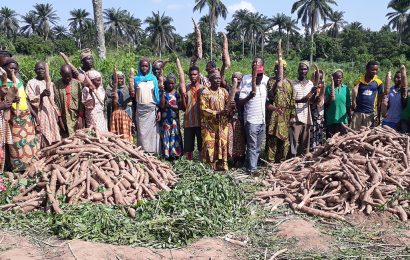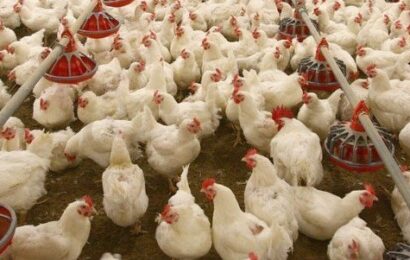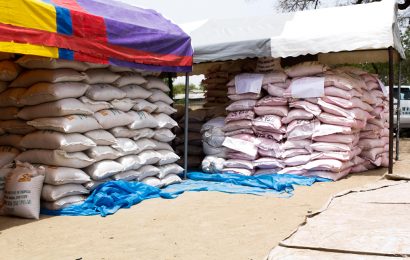The Global Cassava Partnerships for the 21st Century (GCP21) has called for urgent regional approach to halt the spread of cassava mosaic disease (CMD) that is threatening cassava production in Southeast Asia, a region that accounts for about 55 million tons of cassava and host billions of dollars in cassava investment.
Extensive field surveys and stakeholder interaction in the region conducted by CIAT and national partners show that CMD is officially present in 6 provinces of Cambodia and 2 provinces of southern Vietnam.
In a communique issued on Friday, Dr Claude Fauquet, immediate past Director for the GCP21, said the proposal for a regional approach followed a special session that was held during the IVth International Cassava Conference, Benin, June 11-15, 2018.
The international cassava community present at the conference expressed their strong willingness to collaborate with any regional plan to manage the spread of CMD. In particular, cassava colleagues from the African continent can offer extensive accumulated knowledge on CMD, its spread and its control, including diagnostic tools and high yielding CMD-resistant cultivars.
The current spread of the disease in Southeast Asia is estimated to be less than 10% of the total cassava planted area. Based on current knowledge about the CMD outbreak, experts all agreed that the region is at an early stage of the epidemic when it is still possible to restrict the impacts of the disease.
“There is a lot to learn from Africa, a region that had once contained the spread of the disease in the past,” says Dr Alfred Dixon, Director for Development & Delivery at the International Institute of Tropical Agriculture (IITA).
The communique noted that the objective of the special session at the IVth International Cassava Conference, in Benin was to make the international cassava community aware of the problem and to develop practical suggestions for a rapid action plan with all regional stakeholders to control the epidemic of CMD in this part of the world.
The session had four presentations:
The report of the CMD outbreak by Prof. Le Huy Ham from AGI, Vietnam
The economic report from Dr. Jonathan Newby from CIAT-Vietnam
The surveillance report from the virologist Dr. Wilmer Cuellar from CIAT-Colombia
The report on strategies developed with regional stakeholders by Dr. C.M. Fauquet, Director of GCP21
The intent of this session was to demonstrate the importance of cassava in this region of the world which is producing 55 million tons of cassava per year, to show the extent of CMD disease spread and to inform the community about the efforts developed so far to formulate a regional action plan. Experts also agreed that CMD is mostly spreading by the transportation of infected cassava planting material used to plant new fields. The natural whitefly vectors of the virus causing the disease are present on cassava in the region and play a role in spreading virus within fields. They may also play a role in longer distance spread, although this remains to be proven.
Most importantly, the experts pointed out that the transportation and export of starch, chips, flour or fresh roots does not pose a threat of importing disease through any of these products allaying concerns on domestic and export trade. Countries in the region are urged to proactively communicate the status of the disease and join together to mount a coordinated action against the new virus threat to cassava in the region.
Experience with CMD in Africa and Asia has shown that the biggest source of risk for long distance spread from one region to another is the exchange of cassava cuttings. Infected cuttings can be transported hundreds of kilometers in a single day. The whitefly vectors can also contribute to spread of the disease up to 100 kilometers per year. Needless to say, there should be stringent domestic quarantine measures in place to restrict movement of cuttings from infected districts to other districts. Attention should be made to identify disease-free areas to keep them free of the disease. The commercialization of the cassava industry in Southeast Asia offers opportunities for improving the flow of information to prevent movement of infected planting materials.
A possible regional plan of action could comprise the following steps:
Short term actions
Integrate ongoing surveillance data collected by different research groups working in the region to identify currently affected and immediately threatened areas
Mapping variety distribution in areas of high CMD incidence using molecular markers
Dissemination of information to extension services and farmers to improve recognition and management of the disease
Rapid multiplication and distribution of virus-free cuttings to farmers in affected parts of the region
Mid-term action
Importation, testing and multiplication of existing CMD-resistant material in several locations in the region
Introduction segregating populations developed by introgression the source of CMD resistant present in African varieties into LAC and SEA improved materials.
Long-term action
Introgression of virus resistance genes into varieties that meet the regional needs.
The GCP21 has rallied a range of stakeholders in the Southeast Asian region and is planning a regional workshop, to develop a detailed action plan in collaboration with regional stakeholders to rapidly implement urgently needed interventions to prevent CMD from negatively impacting the vibrant cassava industry in the region.
Founded in 2003, GCP21 is a not-for-profit international alliance of 45 organizations and coordinated by Claude Fauquet and Joe Tohme of the International Center for Tropical Agriculture (CIAT). It aims to fill gaps in cassava research and development to unlock the potential of cassava for food security and wealth creation for poor farmers.







